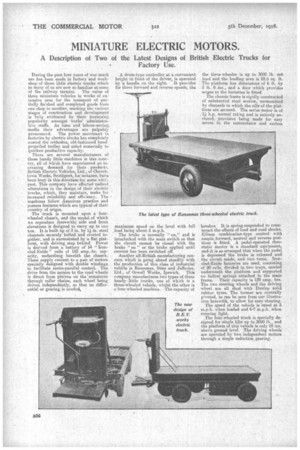• MINIATURE ELECTRIC MOTORS.
Page 14

If you've noticed an error in this article please click here to report it so we can fix it.
A Description of Two of the Latest Designs of British Electric Trucks for • Factory Use.
During the past four years of war much use has been made in factory and workshop of those little electric trunks which to many of us are now so familiar at some
of the railway termini, The value of these miniature vehicles in works of extensive area for the transport of partially finished and completed goods from one shop to another, marking the various stages of construction and development is fully evidenced by their increasins; popularity amongst works administrative staffs. As time and labour-saving media their advantages are palpably pronounced. The power movement in factories by electric trucks has completelv ousted the orthoidox, old-fashioned hand'. propelled trolley and aided materially to quicken productive capacity. . There are several manufacturers of these handy little machines in this Country, all of veWeh have experienced an increasing demand for their products. British Electric Vehicles, Ltd., of ciit.irchtown Works, Southport, for instance, have been busy in this direction for some
past. This company have effected radical alterations in the design of their electric trucks, which, they maintain, make for increased reliability and efficiency. The machines follow American practice and possess features which are typical of their country of origin.
The truck is mounted upon a fourwheeled elsa-s&s, and the model of which we reproduce (herewith) side and front elevations is designed to carry up to one ton. It is built up of 3 in. by 1 in. steel channels securely bolted and riveted together, and is surmotinted by a fiat platform, with driving step behind: Power is derived from a barttery of 14 " Ironclad-Exide " cells of 193 amp.-hr. capacity, undersbang beneath the chassis. These supply current to a pair of motors specially designed with double windings to facilitate series-parallel control. The drive from the motors to the road wheels is direct from piniens on the' armatures through roller chains, each wheel being driven independently, so that no differential or gcs.ring,is needed,
A drum-type controller at a convenient height in front of the driver, is operated by a handle on the right. It provides for three forward and reverse speeds, the maximum speed on the level with full , load being about 5 m.p.h. , The brake is normally " on," and is interlocked with the main switch so that the circuit cannot be closed with the brake " on " or the brake applied until current has been switched off.
Another all-British manufacturing concern which is going ahead steadily with the production of this class of industrial vehicle is Ransomes, Sims and Jefferies, Ltd., of Orwell Works, Ipswich. This company manufactures two types of these handy little trucks, one of which is a three-wheeled vehicle, 'whilst the other is a four-wheeled machine. The capacity of the three-wheeler is up to 3000 lb. net load and the loading area is 22.5 sq. ft. The platform has dimensions of 6 ft. by 3 ft. 9 ins., and a door which provides access to the batteries is fitted.
The chassis frame is rigidly constructed of substantial steel section, surmounted by channels to which the sills of the platform are secured. The series motor is of h.p. normal, rating and is entirely enclosed, provision being made for easy access to the commutator and carbon
brushes. It is spring-suspended to counteract the effects of load and road shocks. Ellison combination-type control with simple forward, neutral and reverse positions is fitted. A pedal-operated rheostatic starter is a standard equipment, and it is so arranged that when the pedal is depressed the brake is released and the circuit made, and vice versa. Ironclad-Exide batteries are used, consisting of 20 cells, divided in two trays, carried underneath the platform and supported on helical springs attached to the main frame. Their capacity is 129 amp. hrs. The two steering wheels and the driving wheel are all shod with Dunlop solid rubber tyres. The former are centrally pivoted, as can be seen from our illustration herewith, to allow for easy steering. The speed of the vehicle is rated at 5 m.p.h. when loaded and 6-7 m.p.h. when running light.
• ,The four-wheeled truck is specially designed for single lifts up to 3000 lb., and the platform of this vehicle is only 10 ins. above ground level. The driving wheels are operated by two independent motors through a single reduction gearing.






















